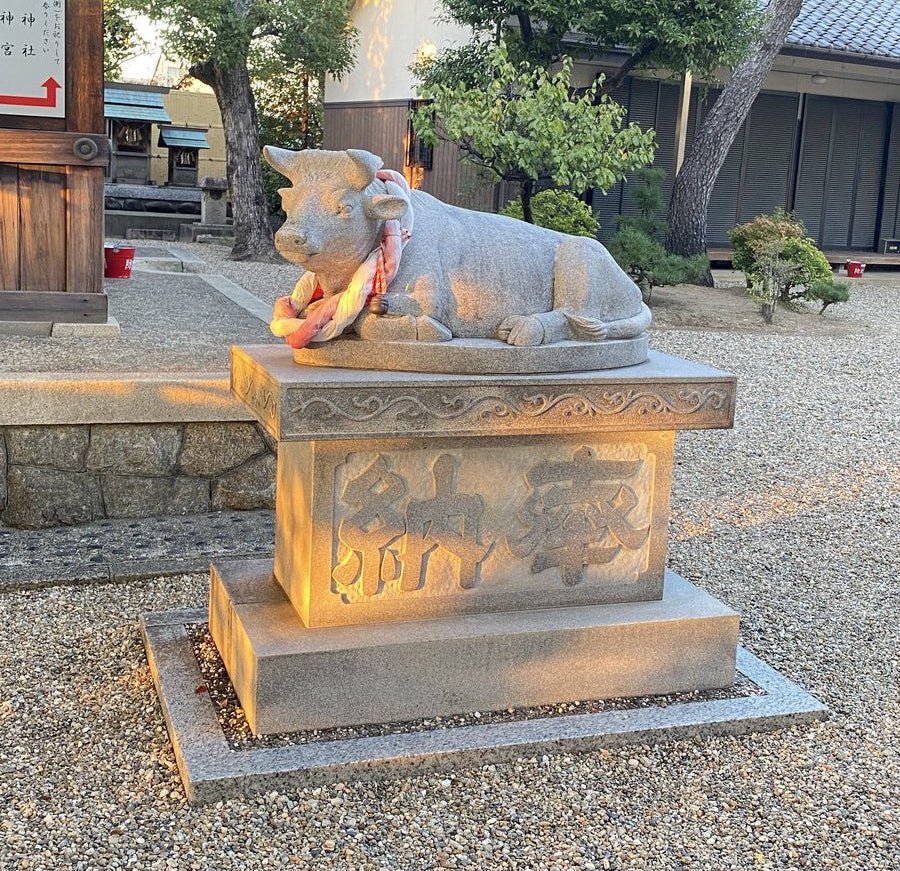
Nagoya Shrine Visit Report 2025 Mizuho No.8 Shinko Tenjinsha
Share
Shinko Tenjinsha and the Tenjin Faith — The Spirit of Learning and Sincerity in Nagoya

Located on a gentle slope in Mizuho Ward, Nagoya, Shinko Tenjinsha enshrines Sugawara no Michizane, the deity of learning known as Tenjin. On October 23, 2025, I visited and photographed the site — the stone name pillar, torii gate, stone lanterns, the hand purification basin, and the granite “nadeushi” (ox statue). As the evening sun illuminated the granite surfaces, the sacred ground seemed to embody the endurance of knowledge and the sincerity of faith.
Overview
| Location | Mizuho-dori 4-34, Mizuho Ward, Nagoya, Aichi, Japan |
|---|---|
| Deity | Sugawara no Michizane |
| Founded | Around 1830–1844 (Tenpō period) |
| Former Name | Shinko-sha (renamed Shinko Tenjinsha in 1983) |
| Annual Festival | October 15 (Autumn Festival) |
| Main Features | Torii gate, ox statue (Nadeushi), stone lanterns, sacred trees, hand purification basin |
Chronology
| Year | Event |
|---|---|
| 1830–1844 | Sacred stone relocated from “Odoriyama” by divine revelation |
| 1869 | Shrine hall constructed at current site |
| 1983 | Renamed from Shinko-sha to Shinko Tenjinsha |
| Afterward | Continues to serve as a guardian shrine and a place of prayer for academic success |
The Origins of the Tenjin Faith
Sugawara no Michizane (845–903) was one of Japan’s greatest scholars and statesmen during the Heian period, celebrated for his integrity and intellect. In political conflict, he was accused—falsely—of plotting imperial succession and was exiled to Dazaifu (present-day Fukuoka Prefecture). This became known as his “unjust exile.”
After his death, a series of lightning strikes and natural calamities struck the capital. The court feared these were the vengeful acts of Michizane’s spirit and enshrined him to appease it. From this arose the Tenjin faith. Michizane was associated with thunder and the heavens, becoming revered as both a Raijin (god of thunder) and a Tenjin (heavenly deity).
Over time, this fear transformed into respect. The vengeful spirit became a deity of sincerity, scholarship, and perseverance. Temples and shrines dedicated to Tenjin spread across Japan. Today, Tenjin is widely known as the patron of learning and culture, attracting countless students and scholars who pray for success and wisdom.
The Faith of Nadeushi (Ox Statues)

The sacred ox statue, known as nadeushi (“stroking ox”), has its roots in legends about Michizane. When exiled, his ox-drawn carriage stopped and refused to move; that place later became the holy site of Dazaifu Tenmangu. After his death, the ox carrying his remains also stopped and lay down—marking the spot for his burial. From these stories, the ox became the divine messenger of Tenjin.
Worshippers stroke the ox on the same body part as their own ailments, believing that their pain will be healed. Stroking the head is said to grant wisdom and academic fortune. Granite or bronze oxen are common throughout Tenjin shrines, their surfaces polished smooth by generations of prayers. The shining patina on their stone surfaces is a quiet testament to faith and time.
When I visited in October 2025, the granite ox at Shinko Tenjinsha glowed warmly in the sunset—its serene presence reflecting the enduring spirit of knowledge.

Major Tenmangu Shrines in Japan
| Name | Location | Features |
|---|---|---|
| Dazaifu Tenmangu | Fukuoka Prefecture | Main shrine built on Michizane’s burial site; origin of the Tenjin faith. |
| Kitano Tenmangu | Kyoto Prefecture | First shrine dedicated to Tenjin; imperial patronage, numerous cultural treasures. |
| Osaka Tenmangu | Osaka Prefecture | Famous for the Tenjin Matsuri festival, blending learning and prosperity worship. |
| Hofu Tenmangu | Yamaguchi Prefecture | Regarded as Japan’s oldest Tenmangu; built before Dazaifu’s foundation. |
| Kameido Tenjinsha | Tokyo | Known as “the Eastern Dazaifu,” famous for its wisteria blossoms. |
| Yushima Tenmangu | Tokyo | A leading shrine for students praying for exam success. |
| Nishinomiya Tenmangu | Hyogo Prefecture | Known for devotion to calligraphy and learning. |
| Tsutsujigaoka Tenmangu | Miyagi Prefecture | A northern shrine with ties to the Date clan. |
| Mito Tenmangu | Ibaraki Prefecture | Guardian deity of learning for the Mito domain. |
| Sapporo Tenjinsha | Hokkaido | Northernmost Tenjin shrine established during Hokkaido’s early development. |
There are about 12,000 Tenmangu or Tenjin shrines across Japan, and when including branch and subsidiary shrines, the number rises to approximately 30,000. Their names vary—“Tenmangu,” “Tenjinsha,” or “Sugawara Shrine”—but all share roots in the reverence for Tenjin.
Personal Observations (Visit on October 23, 2025)

- Approach and Flow: The path from the name pillar through the torii to the main hall is clear and graceful, lined with banners that flutter in rhythm.
- The Beauty of Stone: The lanterns, ox, and purification basin are crafted with precision; in sunset light, the granite textures reveal a subtle interplay of shadow and polish.
- Quiet Time: Evening visits bring serenity—a calm ideal for contemplation, far from the city’s noise.
Conclusion

Shinko Tenjinsha condenses the essence of the Tenjin faith—learning and sincerity—into a small yet profound space in Nagoya. The granite ox, stone lanterns, and hand-washing basin embody Japan’s enduring respect for things that last. As one of about 12,000 Tenjin shrines across Japan, this site continues to inspire those who seek wisdom through effort and honesty.
There are about 80,000 Shinto shrines in Japan. At JapanStones.shop, we visit authentic Japanese shrines and temples, introducing the craftsmanship of genuine stone lanterns, chozubachi (water basins), and koma-inu (guardian dogs) to audiences around the world.
